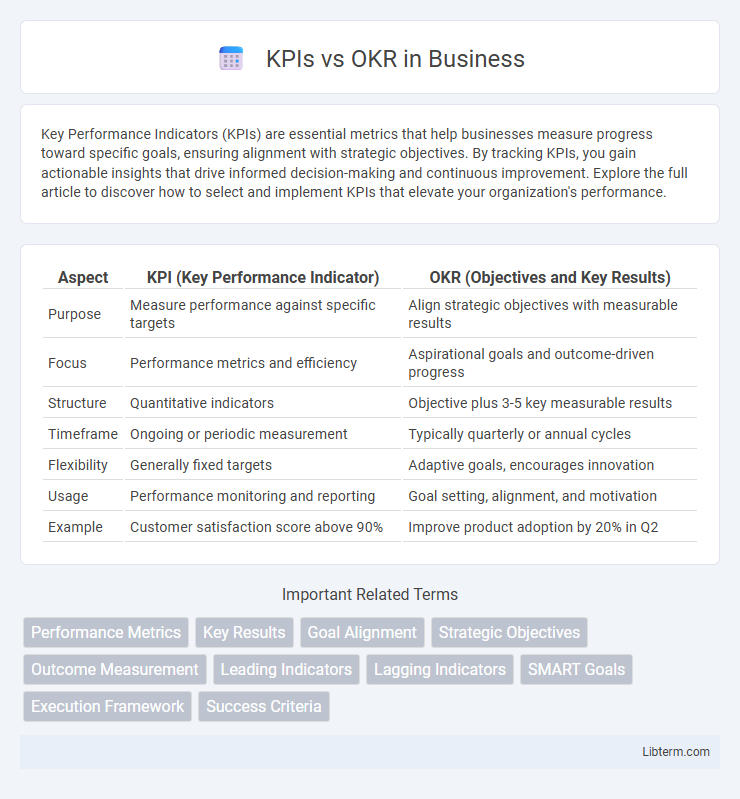Key Performance Indicators (KPIs) are essential metrics that help businesses measure progress toward specific goals, ensuring alignment with strategic objectives. By tracking KPIs, you gain actionable insights that drive informed decision-making and continuous improvement. Explore the full article to discover how to select and implement KPIs that elevate your organization's performance.
Table of Comparison
| Aspect | KPI (Key Performance Indicator) | OKR (Objectives and Key Results) |
|---|---|---|
| Purpose | Measure performance against specific targets | Align strategic objectives with measurable results |
| Focus | Performance metrics and efficiency | Aspirational goals and outcome-driven progress |
| Structure | Quantitative indicators | Objective plus 3-5 key measurable results |
| Timeframe | Ongoing or periodic measurement | Typically quarterly or annual cycles |
| Flexibility | Generally fixed targets | Adaptive goals, encourages innovation |
| Usage | Performance monitoring and reporting | Goal setting, alignment, and motivation |
| Example | Customer satisfaction score above 90% | Improve product adoption by 20% in Q2 |
Understanding KPIs and OKRs
KPIs (Key Performance Indicators) measure specific metrics that track progress toward predefined business objectives, providing quantifiable data on performance efficiency. OKRs (Objectives and Key Results) combine qualitative objectives with measurable key results to align team efforts and drive ambitious outcomes within set timeframes. Understanding KPIs and OKRs helps organizations monitor operational health while fostering strategic goal achievement through clear, measurable targets.
Key Differences Between KPIs and OKRs
KPIs (Key Performance Indicators) measure specific, quantifiable performance metrics that track progress toward operational goals, while OKRs (Objectives and Key Results) define ambitious objectives paired with measurable outcomes to drive strategic alignment and growth. KPIs focus on monitoring existing processes and efficiency, whereas OKRs emphasize setting challenging goals to inspire innovation and transformation. The key difference lies in KPIs providing a status update on performance, whereas OKRs foster goal-setting and continuous improvement through transparent ambition.
The Purpose of KPIs in Business
KPIs (Key Performance Indicators) serve as measurable metrics that track the effectiveness of business processes and help organizations evaluate progress toward specific objectives. They provide quantifiable data that facilitates performance analysis, enabling businesses to identify areas of strength and opportunities for improvement. By focusing on critical success factors, KPIs guide decision-making and resource allocation to enhance operational efficiency and achieve strategic goals.
The Role of OKRs in Strategic Planning
OKRs (Objectives and Key Results) play a crucial role in strategic planning by setting ambitious, measurable goals that align with the organization's vision and drive performance. Unlike KPIs (Key Performance Indicators) that track ongoing operational metrics, OKRs focus on outcome-driven objectives that inspire innovation and prioritize strategic initiatives. Integrating OKRs into strategic planning fosters transparency, accountability, and continuous progress toward long-term success.
How to Choose Between KPIs and OKRs
Choosing between KPIs and OKRs depends on your organization's focus: KPIs measure ongoing performance against specific targets, ideal for tracking efficiency and operational success. OKRs drive ambitious goals with measurable outcomes, fostering innovation and alignment across teams through transparent objectives. Evaluate whether your priority is consistent performance monitoring (KPIs) or setting strategic, growth-oriented milestones (OKRs) to select the most effective framework.
Aligning KPIs and OKRs With Company Goals
Aligning KPIs and OKRs with company goals ensures that performance metrics and objectives directly support strategic priorities, driving focused execution and measurable progress. KPIs quantify critical success factors by tracking ongoing performance, while OKRs set ambitious, time-bound objectives to promote agility and innovation within the organization. Effective alignment requires clear communication and regular review to maintain transparency and adaptability, optimizing resource allocation and maximizing impact on business outcomes.
Common Pitfalls When Implementing KPIs and OKRs
Common pitfalls when implementing KPIs and OKRs include setting unrealistic or vague targets that fail to motivate teams or align with overall business objectives. Organizations often struggle with tracking too many metrics, leading to diluted focus and reduced clarity on priority goals. Lack of regular review and adaptation processes causes KPIs and OKRs to become outdated, limiting their effectiveness in driving performance and strategic outcomes.
Measuring Success: KPIs vs OKRs
KPIs (Key Performance Indicators) measure specific metrics reflecting progress toward predefined business goals, providing quantifiable data to evaluate success. OKRs (Objectives and Key Results) combine ambitious objectives with measurable key results, driving focus and alignment across teams while tracking broader outcomes. Both frameworks complement each other by quantifying performance (KPIs) and setting strategic priorities (OKRs) to effectively measure organizational success.
Best Practices for Managing KPIs and OKRs
Effective management of KPIs and OKRs involves setting clear, measurable objectives aligned with strategic goals, ensuring continuous monitoring and timely updates. Best practices emphasize transparent communication across teams, leveraging real-time data analytics tools for tracking progress, and conducting regular review sessions to adjust targets based on performance insights. Integrating qualitative feedback alongside quantitative metrics enhances decision-making, drives accountability, and fosters a results-oriented culture.
Real-World Examples of KPIs and OKRs in Action
KPIs such as Amazon's website conversion rate measure performance by tracking specific metrics like sales or customer engagement, providing clear benchmarks for operational efficiency. OKRs applied by Google illustrate goal-setting frameworks by outlining ambitious objectives like improving user experience, with key results focused on metrics such as reducing load times by 20%. Real-world application of KPIs and OKRs highlights the complementary roles of precise performance measurement and strategic goal alignment in driving organizational success.
KPIs Infographic

 libterm.com
libterm.com